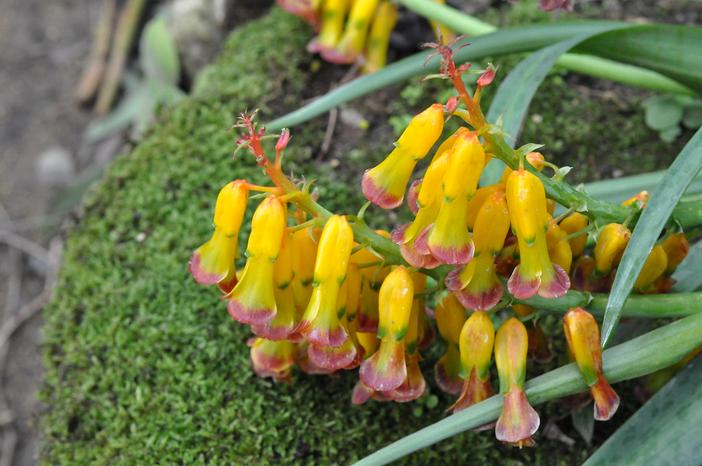Cape Cowslip
(Lachenalia aloides)
Cape Cowslip (Lachenalia aloides)
/
/

Jean-Michel Moullec
CC BY 2.0
Image By:
Jean-Michel Moullec
Recorded By:
Copyright:
CC BY 2.0
Copyright Notice:
Photo by: Jean-Michel Moullec | License Type: CC BY 2.0 | License URL: https://creativecommons.org/licenses/by/2.0/ | Uploader: Enez35 | Publisher: Flickr


















Estimated Native Range
Summary
Lachenalia aloides, commonly known as Cape Cowslip, is a deciduous perennial bulb native to the winter rainfall region of the Western Cape province in South Africa, where it is found in a variety of habitats including sandy flats, rocky outcrops, and coastal areas. It typically grows to 15–28 cm (6–11 in) in height and 5 cm (2 in) in width. The plant is characterized by its strap-shaped, spotted leaves and fleshy stems that bear pendent, tubular flowers which are yellow with red tips, blooming in winter and spring. The flowers are quite showy and make the plant a desirable addition to winter gardens.
Cape Cowslip is valued for its striking flowers and ease of care in suitable climates. It is often used in rock gardens, as a container plant, or in mass plantings for a splash of winter and spring color. While it thrives in full sun, it can also tolerate light shade. It requires low amounts of water and well-drained soil, making it suitable for xeriscaping. Numerous cultivars have been developed, offering a range of flower colors and forms. It is important to protect this plant from frost, so in cooler climates, it should be grown under glass or brought indoors during cold weather. Potential problems include bulb rot if overwatered or planted in poorly drained soils.CC BY-SA 4.0
Cape Cowslip is valued for its striking flowers and ease of care in suitable climates. It is often used in rock gardens, as a container plant, or in mass plantings for a splash of winter and spring color. While it thrives in full sun, it can also tolerate light shade. It requires low amounts of water and well-drained soil, making it suitable for xeriscaping. Numerous cultivars have been developed, offering a range of flower colors and forms. It is important to protect this plant from frost, so in cooler climates, it should be grown under glass or brought indoors during cold weather. Potential problems include bulb rot if overwatered or planted in poorly drained soils.CC BY-SA 4.0
Plant Description
- Plant Type: Bulb
- Height: 0.3-1 feet
- Width: 0.5-1 feet
- Growth Rate: Moderate
- Flower Color: Yellow, Orange, Red
- Flowering Season: Spring, Winter
- Leaf Retention: Deciduous
Growth Requirements
- Sun: Full Sun
- Water: Low
- Drainage: Fast
Common Uses
Bee Garden, Bird Garden, Butterfly Garden, Drought Tolerant, Low Maintenance, Showy Flowers
Natural Habitat
native to the winter rainfall region of the Western Cape province in South Africa, where it is found in a variety of habitats including sandy flats, rocky outcrops, and coastal areas
Other Names
Common Names: Electric Hyacinth, Opal Flower
Scientific Names: , Lachenalia aloides, Lachenalia tricolor, Lachenalia tricolor var. aurea, Lachenalia tricolor var. nelsonii, Phormium aloides, Scilla versicolor,
GBIF Accepted Name: Lachenalia aloides (L.f.) Engl.